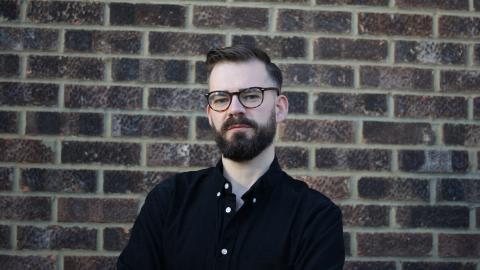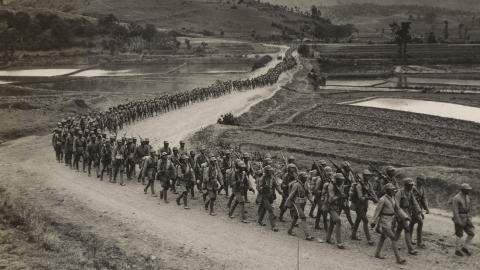How Anne Frank's Diary came to be published
In her diary, Anne wrote that she had plans to publish the book after the war... She had even edited and rewritten a large portion of her original diary.
On 4 August 1944, just two months after the successful Allied landing at Normandy, the Nazi Gestapo discovered the Frank's "Secret Annex." The Franks were sent to the Nazi death camps along with two of the Christians who had helped shelter them, and another Jewish family and a single Jewish man with whom they had shared the hiding place. Anne and most of the others ended up at the Auschwitz concentration camp in Poland. Anne's diary was left behind, undiscovered by the Nazis.
Sky HISTORY spoke to The Anne Frank House in Amsterdam, to find out the legacy of today, what happened in the immediate aftermath and how the diary came to be published.
Can you tell us how the capture of Anne Frank and her family came about?
Until recently, the assumption has always been that the Sicherheitsdienst (SD) arrived at 263 Prinsengracht looking for Jews in hiding and that the raid was clearly the result of a betrayal. Yet, for an ordinary case of wartime betrayal, the story contains many inconsistencies. A new study, conducted by the Anne Frank House revealed that there was more going on at 263 Prinsengracht than just people being hidden in the Secret Annexe. Illegal work and fraud with ration coupons were also taking place there. The current research study provides a different perspective, it is possible that the SD searched the building because of the illegal work and fraud and that the investigators discovered Anne Frank and the seven others in hiding simply by chance.
What happened to the diary in the immediate aftermath of Anne and her families capture? How did the diary go unnoticed?
After the arrest, helper Miep Gies found Anne’s diary together with helper Bep Voskuijl and kept it. Hearing of Anne’s death, she gives the diary to Otto Frank - the only survivor of the eight people in hiding in The Secret Annex - telling him ‘This is your daughter Anne’s legacy.’
How did the diary come to be published?
In her diary, Anne wrote that she had plans to publish the book after the war... She had even edited and rewritten a large portion of her original diary. Initially, Otto Frank felt uncertain about the idea but he finally decided to fulfil his daughter's wish. Later, the diary was translated and adapted to both film and theatre and people all over the world got to know Anne Frank’s story.
For many, it is the most important book of the 20th Century. But when you take a step back and think about it, the legacy and impact are unbelievable.
Anne Frank’s diary has been published in over 70 languages and is famous around the world. Anne’s descriptions of the time in hiding in the 'secret annex', her powers of observation and self-reflection, her fears, hopes and dreams still make a deep impression on readers worldwide. Through Anne’s diary, people begin to learn about the Second World War and the Holocaust, and they read about how it is to be excluded and persecuted. After all these years, Anne’s diary still has contemporary relevance.
In an interview for the Basler Magazin in 1979, Otto said of the popularity of his daughter’s diary, ‘Young people learn little or nothing about this period in school. For most readers, realisation only begins to dawn when they read this book. In that sense, my daughter’s work does indeed fulfil the task of making history tangible. But this doesn’t only concern the “Jewish question”.
Otherwise, the book wouldn’t have gained such popularity, and it wouldn’t be read with such enthusiasm in, for example, Japan or India. What’s more, the diary is, in essence, a “human document”. The letters I receive emphasise very strongly the moment of identification, which has to do with Anne’s belief in the goodness of humanity and her immensely strong optimism, from which young people take an example. But in many countries, Anne is now also a symbol of reconciliation and peace.’
Can you tell us something about the diary that maybe is lesser known?
Anne Frank didn't only write her day-to-day life in her diary, she also wrote stories and collected beautiful sentences.
Also, Anne Frank rewrote her diary. On March 28, 1944, the people in hiding hear a special news report on the Dutch sender broadcasting from London, Radio Oranje (Radio Orange). Dutch Cabinet Minister Bolkestein announced that diaries and other important documents were to be gathered when the war ended as a record of what happened to the Dutch people during World War Two. These were to be preserved for future generations. The people in hiding immediately thought of Anne’s diary.... In May 1944, the idea of this novel takes on serious form, with Anne writing, "At long last after a great deal of reflection I have started my Achterhuis (Secret Annex), in my head it as good as finished, although it won't go as quickly as that, if it ever comes off at all."
Anne revised the major portion of her original diary in the short time left until the arrest of the people in hiding on August 4, 1944. Working on loose sheets of coloured paper, she frequently made simple corrections in the text. Sometimes she deleted entire passages because she thought they were too personal. She still addressed all the letters in her diary to Kitty, her imaginary friend. The last diary entry that Anne rewrote is dated March 29, 1944.
How does the Anne Frank House build on her legacy today?
The Anne Frank House was established on 3 May 1957, with the close involvement of Anne’s father, Otto Frank. It is an independent, non-profit organisation dedicated to the preservation of Anne Frank’s hiding place, her diaries and to spreading the message of Anne Frank’s life and ideals worldwide. On the basis of Anne Frank’s life story, set against the background of the Holocaust and the Second World War, the Anne Frank House develops educational programmes and products with the aim of raising young people’s awareness of the dangers of anti-Semitism, racism and discrimination and the importance of freedom, equal rights and democracy. Today the Anne Frank House organisation has a much greater reach among young people than Otto Frank could ever have imagined.
















